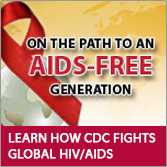Namibia
HIV/AIDS in Namibia
- 14.3% Estimated HIV Prevalence
(Age 15–49)(2013) - 6,600 Estimated AIDS Deaths (2013)
- 96,000 Estimated Orphans due to AIDS (2013)
- 105,347 Reported Number of Adults Receiving Antiretroviral Therapy (ART)(2012)
- 91% Estimated ART Coverage per WHO 2010 Guidelines (2012)
SOURCE:
UNAIDS Gap Report, 2014; UNAIDS Global Report, 2013

Strategic Focus
Since 2002, CDC-Namibia has assisted the Namibian Ministry of Health and Social Services (MoHSS) to develop and implement an integrated, comprehensive package of HIV/AIDS prevention, care, and treatment programs. CDC-Namibia provides targeted technical assistance by building the capacity of Namibia’s healthcare workforce to lead and manage its HIV program more effectively. Technical assistance has strengthened national efforts to prevent the sexual and biomedical transmission of HIV, expand care and treatment services, and help prevent mother- to-child transmission of HIV. In line with PEPFAR’s mission, the aim of all support to MoHSS is to ensure that Namibia soon achieves an AIDS-Free generation.
Strengthening Human Resources for Health
CDC provides support to national and regional health training centers to implement and scale-up nurse initiated management of antiretroviral therapy (ART). Empowering and equipping nurses to initiate ART will enable more individuals to receive treatment in many of Namibia’s rural communities. Additionally, CDC supports the Field Epidemiology and Laboratory Training Program (FELTP), which trains Namibians on basic epidemiology, data analysis, and interpretation to build the capacity of the health care workforce.
Strengthening Laboratory Systems and Networks
The Namibia Institute of Pathology (NIP) is receiving CDC technical support to roll-out and routinize viral load testing. As Namibia continues to decentralize services and works to reach the UNAIDS target of 90% of all individuals on ART maintaining viral load suppression, a strong lab system and network is critical. CDC also works with NIP to ensure the quality of all HIV and TB testing nationally.
For more information on CDC-Namibia, read the latest PAMWE Issue (June 2014), a public health magazine published by CDC-Namibia.
Key Activities and Accomplishments
Supporting Prevention of Mother-to-Child HIV Transmission (PMTCT) with Roll-Out of Option B+
CDC-Namibia provides technical assistance to national and regional programs to roll-out Option B+. Technical assistance consists of development of guidelines and standard operating procedures, training of antenatal clinic (ANC) nurses, and nurse clinical mentors to better support providers at high volume sites.
Enhancing HIV Prevention, Care, and Treatment for All Namibians
In November 2014, Namibia launched its new National HIV Testing and Counselling Strategy with the primary message; test early, treat early. CDC provided technical assistance to the MoHSS to design this new strategy which focuses on data-driven community-based testing as well as provider initiated testing and counselling (PITC) in inpatient wards, at TB clinics, and ANC sites. Additionally, CDC is providing targeted assistance to HIV treatment sites in high prevalence regions to identify gaps along the clinical cascade, improve quality management and quality improvement, and train and mentor clinical staff to better serve patients.
Success Stories
- Saving Lives and Improving HIV Care in Namibia
- Sarafina’s Story: An Exceptional HIV Counseling and Testing Provider in Namibia
Previous PAMWE issues:
Contact Us:
- Centers for Disease Control and Prevention
1600 Clifton Rd
Atlanta, GA 30333 - 800-CDC-INFO
(800-232-4636)
TTY: (888) 232-6348
24 Hours/Every Day - cdcinfo@cdc.gov
 ShareCompartir
ShareCompartir



